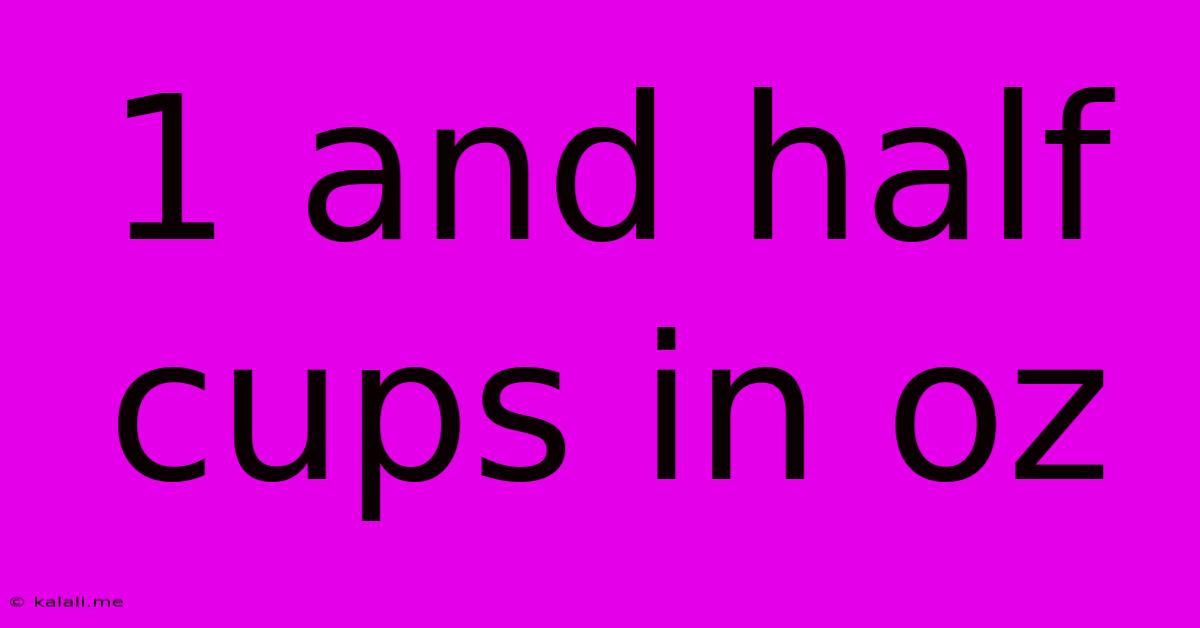1 And Half Cups In Oz
Kalali
May 09, 2025 · 3 min read

Table of Contents
1 ½ Cups in Ounces: A Quick Conversion Guide
Knowing how to convert cups to ounces is a crucial skill for anyone who bakes, cooks, or simply needs to measure ingredients accurately. This article will clearly explain how to convert 1 ½ cups into ounces, covering different liquid and dry ounce measurements to ensure you're always precise in your culinary endeavors. We'll also cover some common scenarios where this conversion is helpful.
Understanding the Difference: Fluid Ounces vs. Dry Ounces
Before we dive into the conversion, it's vital to understand the distinction between fluid ounces (fl oz) and dry ounces (oz). Fluid ounces measure volume of liquids, while dry ounces measure the weight of dry ingredients. This difference significantly impacts the conversion process.
Converting 1 ½ Cups to Fluid Ounces
There are 8 fluid ounces in 1 cup. Therefore, to convert 1 ½ cups to fluid ounces, we perform the following calculation:
1 ½ cups * 8 fl oz/cup = 12 fl oz
Therefore, 1 ½ cups is equal to 12 fluid ounces. This is a standard conversion and applies to most liquids like water, milk, juice, and other similar ingredients in baking and cooking recipes.
Converting 1 ½ Cups to Dry Ounces (Approximate)
Converting 1 ½ cups to dry ounces is trickier because it depends heavily on the density of the dry ingredient. There's no single definitive conversion factor. However, we can provide approximations based on common ingredients:
-
For ingredients like flour: 1 cup of all-purpose flour generally weighs approximately 4 ounces. Therefore, 1 ½ cups would be approximately 6 ounces. However, the weight can vary depending on how tightly or loosely the flour is packed.
-
For ingredients like sugar: 1 cup of granulated sugar typically weighs around 7.5 ounces. Consequently, 1 ½ cups of granulated sugar would weigh approximately 11.25 ounces. Again, packing density influences this weight.
-
For other dry ingredients: The weight per cup will vary significantly for ingredients like nuts, seeds, or grains. You'll find it most accurate to weigh these ingredients using a kitchen scale for precise measurements.
Why Accurate Measurement Matters
Accurate measurement is paramount in cooking and baking, especially when working with recipes that require specific ratios of ingredients. Using the correct conversion and employing a kitchen scale for dry ingredients leads to better results, ensuring your dishes consistently turn out as intended. This improves consistency and helps avoid unexpected outcomes due to inaccurate measurements.
Common Scenarios Requiring this Conversion
-
Baking: Many baking recipes call for specific volumes of liquids, where converting cups to fluid ounces might offer greater precision.
-
Cooking: Similar to baking, precise measurements are essential, even for cooking. Understanding this conversion helps you adapt recipes and ensure accurate ingredient proportions.
-
Nutrition: Knowing the volume and approximate weight of ingredients helps in tracking nutritional intake.
In conclusion, while converting 1 ½ cups to 12 fluid ounces is straightforward, remember that converting to dry ounces requires considering the specific ingredient's density and using a kitchen scale for the most accurate results. Always prioritize precision in your culinary efforts for the best possible outcomes.
Latest Posts
Latest Posts
-
34 Centimeters Equals How Many Inches
May 09, 2025
-
Are Humans Hot Or Cold Blooded
May 09, 2025
-
How Much Is 10 Minutes In Seconds
May 09, 2025
-
1 73 M To Ft And Inches
May 09, 2025
-
What Is 3 5 In A Fraction
May 09, 2025
Related Post
Thank you for visiting our website which covers about 1 And Half Cups In Oz . We hope the information provided has been useful to you. Feel free to contact us if you have any questions or need further assistance. See you next time and don't miss to bookmark.